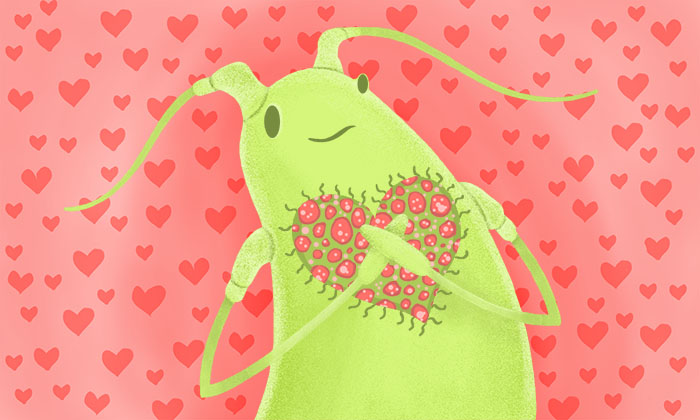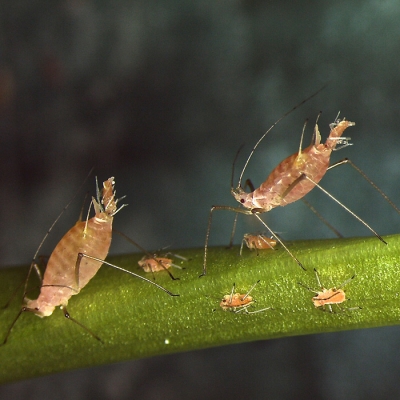In the world of living things, surely one of the oddest relationships is the one between certain insects and the bacteria they can't seem to live without. Such bacteria, called obligate symbionts live inside the host's cells. They're distinct organisms -- they have their own DNA separate from that of the host. And yet, if you try to remove the bacteria, the host dies. And vice versa.
 The pea aphid is a major agricultural pest worldwide, a trouble-maker sucking the sap from peas, alfalfa and other valuable crops. But the pea aphid has a can’t-quit-you relationship with the bacterium Buchnera.
The pea aphid is a major agricultural pest worldwide, a trouble-maker sucking the sap from peas, alfalfa and other valuable crops. But the pea aphid has a can’t-quit-you relationship with the bacterium Buchnera.
Like many biologists, Nancy Moran, a professor at The University of Texas at Austin wondered what the heck these bacteria were doing inside the aphid's cells. But because host and symbiont are so enmeshed, like gears and springs in a watch, no one could figure out how to pop it open and poke around without the watch grinding to a halt. In a paper published in the Proceedings of the National Academy of Sciences last month, she described a new technique that is beginning to reveal the intricate workings of this relationship.
Undergraduates Get Research Experience
Nancy Moran leads a small team of undergraduate researchers as part of a program called the Freshman Research Initiative (FRI). In the newly formed "Microorganisms in Honey Bees and Other Insects" research stream, students will explore the gut microbiota of insects. They will sample insects from wild populations and from laboratory colonies and use these to explore the role of gut microorganisms in the health and functioning of their hosts. An emphasis will be placed on ecologically important insects such as honey bees and other pollinators. Students will learn about natural history and insect biology, microbiological methods and use of bioinformatics to explore biodiversity of microorganisms and their role in natural ecosystems.
It all started a couple of years ago when researchers in Japan discovered, when an aphid embryo is developing inside its mother, some of the mother's bacterial symbionts are floating around freely outside of the mother's cells. Only later do they infect the cells of the developing embryo. Before that study, no one knew how and when the symbionts were transmitted from mother to child.
Moran realized that this might provide a brief window of opportunity to wipe out the free-floating symbionts before they infected the developing embryo and replace them with symbionts from another strain of aphid. Why? Because switching symbionts from one strain of aphid to another might reveal what purpose the bacteria served for the aphid. Scientists think these codependent critters’ relationship has been going on for millions of years, the bacteria passed from generation to generation over many years. The two organisms have evolved together, through thick and thin. So today, among pea aphids, there are many distinct strains, each with their own unique symbionts. Because the aphid strains have evolved along different paths, their symbionts probably behave differently too. So what Moran really wanted to know was, if you swapped symbionts between two strains of aphid, would the resulting aphids look or act differently than their mothers?
 Moran worked with visiting researcher Yueli Yun on the complicated symbiont-swapping process. Moran figured the chances that it would work were slim, but in just a few short months, they had successfully transplanted the symbionts from one strain of aphid to another – and discovered that at least one strain of symbiont endows its host with heat tolerance.
Moran worked with visiting researcher Yueli Yun on the complicated symbiont-swapping process. Moran figured the chances that it would work were slim, but in just a few short months, they had successfully transplanted the symbionts from one strain of aphid to another – and discovered that at least one strain of symbiont endows its host with heat tolerance.
"This means the symbiont has a big effect on the kind of environment in which the aphid can live," says Moran, who notes that the finding could help researchers seeking new pest-control measures for farmers. "Knowing aphids require their symbionts to reproduce and finding a specific vulnerability of the symbionts could result in a means of preventing aphid growth."
Moran is especially interested in understanding how these entwined organisms evolved. Next, she plans to use the technique she and Yun developed to attempt to swap symbionts between pea aphids and an entirely different aphid species. Would such a hybrid insect live a normal life? Would it be able to reproduce with members of its own parent species? And if not, would that make it a new species? Stay tuned.
Nancy Moran holds the Leslie Surginer Endowed Professorship in the Department of Integrative Biology.

















Comments 1
Really interesting article. Amazing the processes of maintaining life that can be discovered when delved into by creative and intelligent evolutionary biologists. Thank you Drs. Moran and Yueli for your work that will hopefully benefit not only our food supply but also further our understanding between hosts and symbionts.